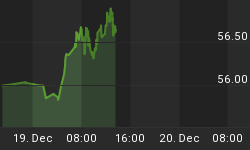The following chart is a modified update of the last chart in my July 3, 2003 communication. The modification consists of plotting only the 1st 115 trading days following each buy signal (given that only 115 trading days have elapsed since the 5/30/03 signal.)

The following 2 line charts are modified updates of the 2nd and 3rd charts in my August 4, 2003 communication. The modification consists of changing the time spans to cover the 500 trading days before and the 500 trading days after each of the 2 buy signals (where possible, that is, given that only 115 trading days have elapsed since the 5/30/03 signal).


The purpose of this latter modification is to make the 2 line charts comparable timewise to the Monthly DJIA line chart shown below (as borrowed from my October 31, 2003 communication).

Finally, heres an updated chart of Peter Eliades' CI-NCI Ratio in its pure form.

As to all of the above charts, it's still too soon to ascertain whether or not post-5/30/03 paths are tracking post-4/28/78 paths well enough for them to constitute a post-signal pattern pair.















